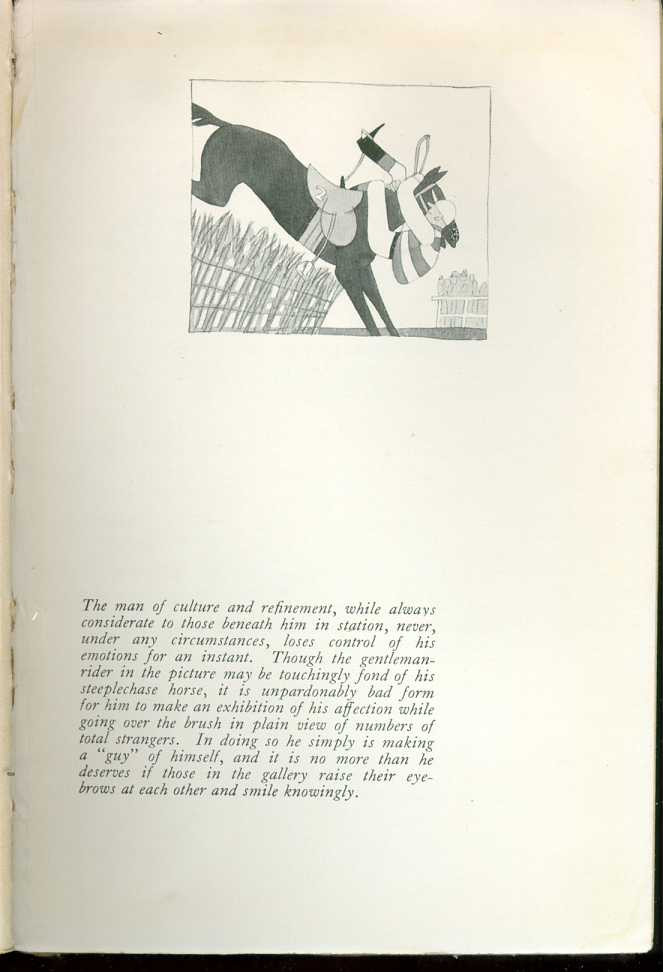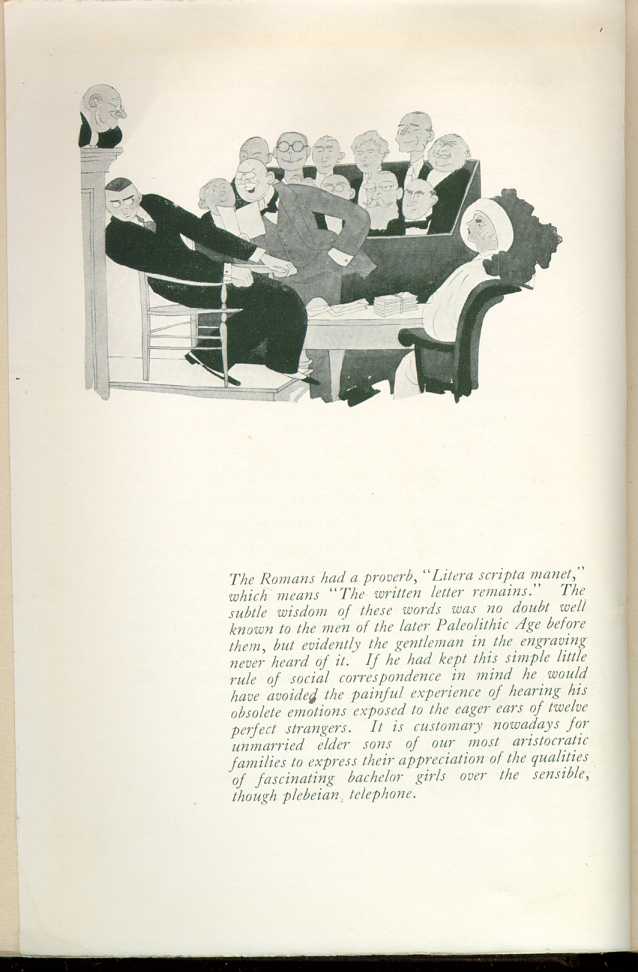|
CHAPTER TWO: THE ETIQUETTE OF ENGAGEMENTS AND WEDDINGS
Perfect Behavior | ||
A CHURCH WEDDING
ON the day of the wedding the ushers should arrange to be at the church an hour or so in advance of the time set for the ceremony. They should be dressed in cutaways,
It is the duty of the best man to dress the bridegroom for the wedding. As you enter his room you see, lying half-dressed on the bed, a pale, wan, emaciated creature, who is staring fixedly at the ceiling. It is the happy bridegroom. His lips open. He speaks feebly. "What time is it?" he says. You reply, "Two-thirty, old man. Time to start getting dressed." "Oh, my God!" says the groom. Ten minutes pass. "What time is it?" says the groom. "Twenty of three," you reply. "Here's your shirt." "Oh, my God!" says the groom.
He takes the shirt and tries to put it on. You help him. "Better have a little Scotch, old man," you say. "What time is it?" he replies. "Five of three," you say. "Oh, my God!" says the groom.
At three-thirty you and he are dressed in cutaways and promptly at three-forty-two you arrive at the church. You are ushered into a little side room where it is your duty to sit
Meanwhile the ushers have been performing their duty of showing the invited guests to the various pews. A correctly trained usher will always have ready some cheery word or sprightly bit of conversation to make the guests feel perfectly at home as he conducts them to their seats. "It's a nice day, isn't it?" is suggested as a perfectly safe and yet not too unusual topic of conversation. This can be varied by remarking, "Isn't it a nice day?" or in some cases, where you do not wish to appear too forward, "Is it a nice day, or isn't it?" An usher should also remember that

The man of culture and refinement, while always considerate to those beneath him in station, never, under any circumstances, loses control of his emotions for an instant. Though the gentleman-rider in the picture may be touchingly fond of his steeplechase horse, it is unpardonably bad form for him to make an exhibition of his affection while going over the brush in plain view of numbers of total strangers. In doing so he simply is making a "guy" of himself, and it is no more than he deserves if those in the gallery raise their eyebrows at each other and smile knowingly.
[Description: Drawing of a man hanging onto a horse's neck as the horse jumps over a gate. ]
The Romans had a proverb, "Litera scripta manet," which means "The written letter remains." The subtle wisdom of these words was no doubt well known to the men of the later Paleolithic Age before them, but evidently the gentleman in the engraving never heard of it. If he had kept this simple little rule of social correspondence in mind he would have avoided the painful experience of hearing his obsolete emotions exposed to the eager ears of twelve perfect strangers. It is customary nowadays for unmarried elder sons of our most aristocratic families to express their appreciation of the qualities of fascinating bachelor girls over the sensible, though plebeian, telephone.
[Description: Drawing of a man reading a letter to a courtroom. ]The first two pews on each side of the center aisle are always reserved for members of the immediate family, but it is a firmly established custom that the ushers shall seat in these "family pews" at least three people with whom the family are barely on speaking terms. This slight error always causes Aunt Nellie and Uncle Fred to sit up in the gallery with the family cook.
With the arrival of the bride, the signal is given to the organist to start the wedding march, usually either Mendelssohn's or Wagner's. About this time the mother of the bride generally discovers that the third candle from the left on the rear altar has not been lighted, which causes a delay of some fifteen minutes during which time the organist improvises one hundred and seventy-three variations on the opening strains of the march.
Finally all is adjusted and the procession starts down the aisle led by the ushers swaying slowly side by side. It is always customary for three or four of the eight ushers to have absolutely no conception of time or rhythm, which adds a quaint touch of uncertainty and often a little humor to the performance.
After the Scotch mist left by the passing ushers has cleared, there come the bridesmaids, the maid of honor, and then, leaning on her father's arm (unless, of course, her father is dead), the bride.
In the meantime, the bridegroom has been carried in by the best man and awaits the procession at the foot of the aisle, which is usually four hundred and forty yards long. The ushers and bridesmaids step awkwardly to one side; the groom advances and a hush falls over the congregation which is the signal for the bride's little niece to ask loudly, "What's that funny looking man going to do, Aunt Dotty?"
Then follows the religious ceremony.
Immediately after the church service, a reception
The wedding "festivities" are generally concluded with the disappearance of the bride, the bridegroom, one of the uninvited guests and four of the most valuable presents.
|
CHAPTER TWO: THE ETIQUETTE OF ENGAGEMENTS AND WEDDINGS
Perfect Behavior | ||